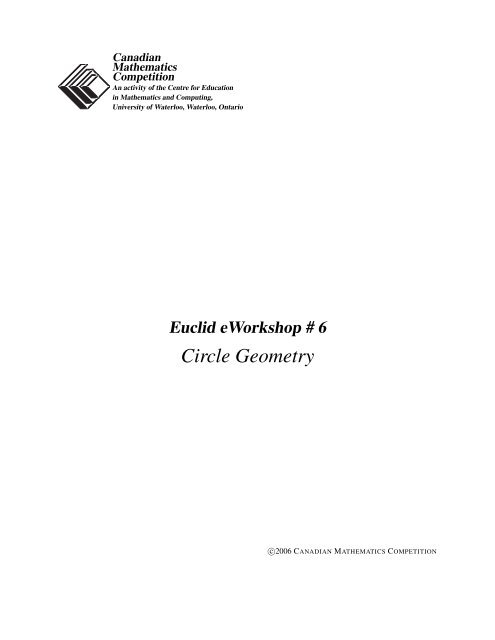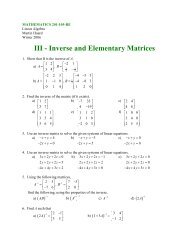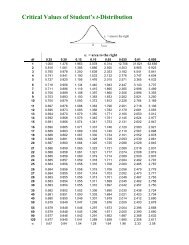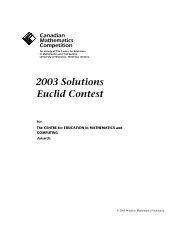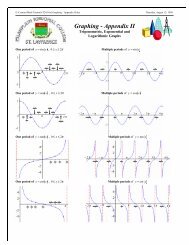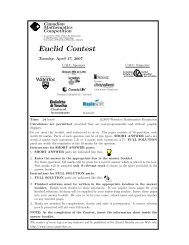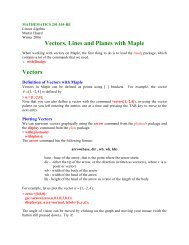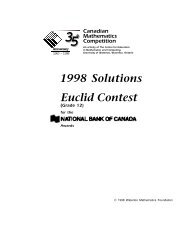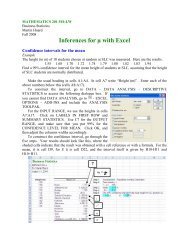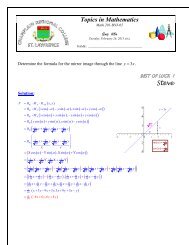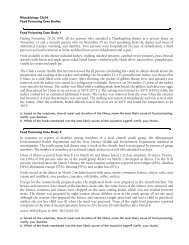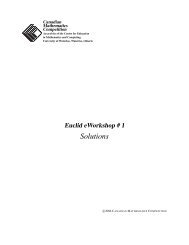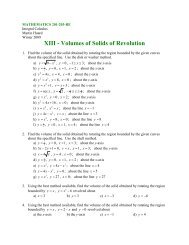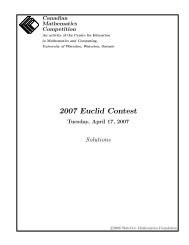Circle Geometry - CEMC - University of Waterloo
Circle Geometry - CEMC - University of Waterloo
Circle Geometry - CEMC - University of Waterloo
You also want an ePaper? Increase the reach of your titles
YUMPU automatically turns print PDFs into web optimized ePapers that Google loves.
Canadian<br />
Mathematics<br />
Competition<br />
An activity <strong>of</strong> the Centre for Education<br />
in Mathematics and Computing,<br />
<strong>University</strong> <strong>of</strong> <strong>Waterloo</strong>, <strong>Waterloo</strong>, Ontario<br />
Euclid eWorkshop # 6<br />
<strong>Circle</strong> <strong>Geometry</strong><br />
c○2006 CANADIAN MATHEMATICS COMPETITION
Euclid eWorkshop #6<br />
CIRCLE GEOMETRY<br />
CIRCLE GEOMETRY<br />
<strong>Geometry</strong> and more specifically the geometry <strong>of</strong> the circle represents an area <strong>of</strong> mathematics from which relatively<br />
difficult and interesting problems for the Euclid contest are frequently taken. Although this is a very broad content<br />
area, we present only a brief outline <strong>of</strong> some <strong>of</strong> the more elementary results <strong>of</strong> the geometry <strong>of</strong> the circle. We will<br />
assume that the student has some knowledge <strong>of</strong> the elementary properties <strong>of</strong> triangles, including congruence and similarity,<br />
as well as the properties <strong>of</strong> parallelograms, rhombi and trapezoids that follow from these properties <strong>of</strong> triangles.<br />
The ‘Star Trek’ Theorem<br />
The central angle subtended by any arc is twice any <strong>of</strong> the inscribed angles on that arc. In other words, in the<br />
accompanying figure ∠AOB = 2∠ACB.<br />
Demonstration<br />
This theorem is the lynchpin <strong>of</strong> all the results that follow.<br />
It is useful to give a brief demonstration <strong>of</strong> this property to see that if follows directly from the properties <strong>of</strong> isosceles<br />
triangles.<br />
C<br />
O<br />
A<br />
L<br />
B<br />
In the diagram we draw the line connecting C and O and let a point on CO extended be L. Since OA, OB and OC are<br />
radii we have that the triangles OAC and OBC are isosceles. Thus ∠OAC = ∠OCA. Furthermore<br />
∠OAC + ∠OCA = ∠AOL, the exterior angle <strong>of</strong> the triangle. Therefore ∠OCA = 1 (∠AOL). Similarly<br />
2<br />
∠OCB = 1 2 (∠BOL).<br />
Adding these 2 results ∠ACB = ∠ACO + ∠OCB = 1 2 (∠AOL + ∠LOB) = 1 2 ∠AOB.<br />
Extensions<br />
See if you can extend this theorem to obtain each <strong>of</strong> the following:<br />
1. Show that if the chord AB is a diameter then ∠ACB = 90 ◦ . (The angle subtended by a diameter is a right<br />
angle).<br />
2. Show that the result is still true if ∠AOB is greater than 180 ◦ .<br />
3. Show that the result is true in the case where the point C is chosen so that the segments AC and OB intersect,<br />
that is, when C is moved along the circle towards the point B. (This pro<strong>of</strong> will use differences where the earlier<br />
pro<strong>of</strong> uses sums).<br />
4. Show that if C 1 and C 2 are 2 different choices for the position <strong>of</strong> the point C along the arc AB then<br />
∠AC 1 B = ∠AC 2 B. This result is described as ‘angles subtended by the same arc(or chord) are equal’.<br />
(The two points must both lie on the same side <strong>of</strong> the chord).<br />
5. If C 1 and C 2 are two points on the circle, one on the minor arc AB and the other on the major arc AB, prove<br />
that ∠AC 1 B + ∠AC 2 B = 180 ◦ (the opposite angles <strong>of</strong> a cyclic quadrilateral are supplementary).<br />
CANADIAN MATHEMATICS COMPETITION 2
Euclid eWorkshop #6<br />
CIRCLE GEOMETRY<br />
The ‘Crossed Chord’ Theorem<br />
If two chords AB and CD <strong>of</strong> a circle intersect at the point P as shown in the diagram, prove that<br />
(P A)(P B) = (P C)(P D).<br />
A<br />
D<br />
P<br />
B<br />
C<br />
Pro<strong>of</strong><br />
Draw the line segments joining the points AD and BC. Then we observe using the result (4) above that<br />
∠BCD = ∠BAD and ∠ADC = ∠ABC. Thus ∆ADP is similar to ∆CBP by the angle-angle similarity. Thus<br />
P A<br />
P C = P D , and by cross-multiplying we arrive at (P A)(P B) = (P C)(P D).<br />
P B<br />
Problem<br />
Two perpendicular chords AB and CD intersect at P . If P A = 4, P B = 10 and CD = 13, calculate the length <strong>of</strong><br />
the radius <strong>of</strong> the circle.<br />
C<br />
A<br />
N<br />
D<br />
O<br />
P<br />
M<br />
B<br />
Solution<br />
We let x represent the length PC. Then, using the Crossed Chord Theorem, x(13 − x) = 4(10) and x = 5 or<br />
8. Now we label the midpoints AB and CD as M and N. Thus MB = 10 + 4 = 7 and NC = 8 + 5 = 13 2<br />
2 2 .<br />
Thus NP =<br />
∣ 8 − 13 ∣ ∣∣∣ 2 ∣ or 5 − 13<br />
2 ∣ = 3 . However the line segment joining the centre <strong>of</strong> a circle to the midpoint<br />
<strong>of</strong> a chord is perpendicular to the chord and the chords were given perpendicular, so OMP N is a<br />
2<br />
rectangle.<br />
Thus OM = NP = 3 and we can use the theorem <strong>of</strong> Pythagoras in triangle OMB to calculate the radius<br />
√<br />
2<br />
( ) 2<br />
√<br />
3 205<br />
r = OB = 7 2 + = .<br />
2 2<br />
CANADIAN MATHEMATICS COMPETITION 3
Euclid eWorkshop #6<br />
CIRCLE GEOMETRY<br />
Extension<br />
In the diagram, P AB and P CD are two secants <strong>of</strong> the same circle and they intersect at the point P outside the circle.<br />
Prove that (P A)(P B) = (P C)(P D).<br />
D<br />
B<br />
C<br />
A<br />
T<br />
P<br />
Solution<br />
Consider △P AD and △P CB. Since both share ∠AP C we need only have one more pair <strong>of</strong> angles equal to establish<br />
similarity. But ∠ADC and ∠ABC both are subtended by the arc AC and so are equal. Thus ∆P AD is similar to<br />
∆P CB and using the same logic as above we arrive at (P A)(P B) = (P C)(P D).<br />
Now imagine a series <strong>of</strong> secants passing through P , each intersecting the circle at two points but with the chord that<br />
is within the circle getting shorter and shorter as the secant approaches the point where it intersects the circle at a<br />
single point. In this case the secant becomes a tangent to the circle at the limiting point <strong>of</strong> intersection which we<br />
label T . We notice that as this process takes place, P A approaches P T and P B approaches P T . Thus we have<br />
(P A)(P B) = (P C)(P D) = (P T ) 2 . Try to prove this last statement directly using similarity and result (IV) below!<br />
Other Important Properties <strong>of</strong> Tangents<br />
If P is a point outside <strong>of</strong> a circle and we draw the two tangents to the circle P T and P S then the following results<br />
follow:<br />
I. A tangent at a point on a circle is perpendicular to the radius drawn to the point. (OT is perpendicular to P T )<br />
II. P S = P T : Tangents to a circle from an external point are equal.<br />
III. OP bisects the angle between the tangents. (∠T P S).<br />
O<br />
S<br />
T<br />
P<br />
IV. Tangent Chord Theorem: Given that T A is any chord <strong>of</strong> a circle and P T is tangent to the circle at T . If C is<br />
a point on the circle chosen to be on the side <strong>of</strong> the chord opposite to the tangent then ∠T CA = ∠P T A.<br />
C<br />
O<br />
A<br />
T<br />
P<br />
Pro<strong>of</strong><br />
Since we know OT is perpendicular to T P we draw in the radii OT and OA. Since the tangent is perpendicular<br />
to the radius, ∠P T A = 90 ◦ − ∠AT O = 1 2 (180◦ − ∠AT O − ∠OAT ) = 1 (∠AOT ) = ∠ACT .<br />
2<br />
CANADIAN MATHEMATICS COMPETITION 4
Euclid eWorkshop #6<br />
CIRCLE GEOMETRY<br />
PROBLEM SET<br />
1. In a circle with centre O, two chords AC and BD intersect at P . Show that ∠AP B = 1 (∠AOB + ∠COD).<br />
2<br />
2. If the points A, B, C and D are any 4 points on a circle and P , Q, R and S are the midpoints <strong>of</strong> the arcs AB,<br />
BC, CD and DA respectively, show that P R is perpendicular to QS.<br />
3. Calculate the value <strong>of</strong> x.<br />
3x<br />
x<br />
2x<br />
4. The three vertices <strong>of</strong> triangle ABC lie on a circle. Chords AX, BY, CZ are drawn within the interior angles<br />
A, B, C <strong>of</strong> the triangle. Show that the chords AX, BY and CZ are the altitudes <strong>of</strong> triangle XY Z if and only if<br />
they are the angle bisectors <strong>of</strong> triangle ABC.<br />
5. As shown in the diagram, a circle with centre A and radius 9 is tangent to a smaller circle with centre D and<br />
radius 4. Common tangents EF and BC are drawn to the circles making points <strong>of</strong> contact at E, B and C.<br />
Determine the length <strong>of</strong> EF .<br />
A<br />
B<br />
F<br />
E<br />
C<br />
D<br />
6. In the diagram, two circles are tangent at A and have a common tangent touching them at B and C respectively.<br />
(a) Show that ∠BAC = 90 ◦ . (Hint: with touching circles it is usual to draw the common tangent at the point<br />
<strong>of</strong> contact!)<br />
(b) If BA is extended to meet the second circle at D show that CD is a diameter.<br />
B<br />
C<br />
A<br />
D<br />
CANADIAN MATHEMATICS COMPETITION 5
Euclid eWorkshop #6<br />
CIRCLE GEOMETRY<br />
7. If ABCD is a quadrilateral with an inscribed circle as shown, prove that AB + CD = AD + BC.<br />
D<br />
A<br />
B<br />
C<br />
8. In this diagram, the two circles are tangent at A. The line BDC is tangent to the smaller circle. Show that AD<br />
bisects ∠BAC.<br />
A<br />
B<br />
D<br />
C<br />
9. Starting at point A 1 on a circle, a particle moves to A 2 on the circle along chord A 1 A 2 which makes a clockwise<br />
angle <strong>of</strong> 35 ◦ to the tangent to the circle at A 1 . From A 2 the particle moves to A 3 along chord A 2 A 3 which<br />
makes a clockwise angle <strong>of</strong> 37 ◦ to the tangent at A 2 . The particle continues in this way. From A k it moves to<br />
A k+1 along chord A k A k+1 which makes a clockwise angle <strong>of</strong> (33 + 2k) ◦ to the tangent to the circle at A k .<br />
After several trips around the circle, the particle returns to A 1 for the first time along chord A n A 1 . Find the<br />
value <strong>of</strong> n.<br />
A 1<br />
A 2<br />
A 3<br />
37 0<br />
35 0 39 0<br />
41 0 A 4<br />
CANADIAN MATHEMATICS COMPETITION 6


